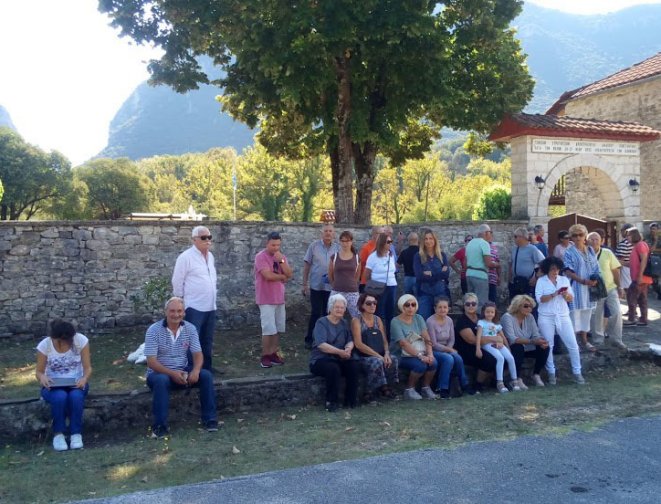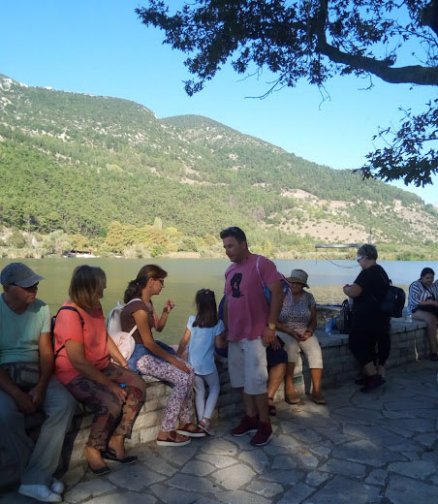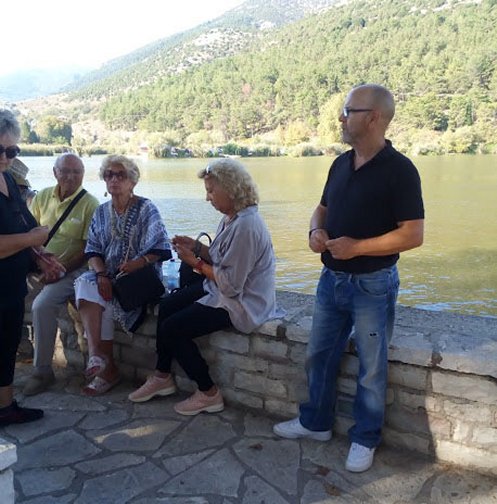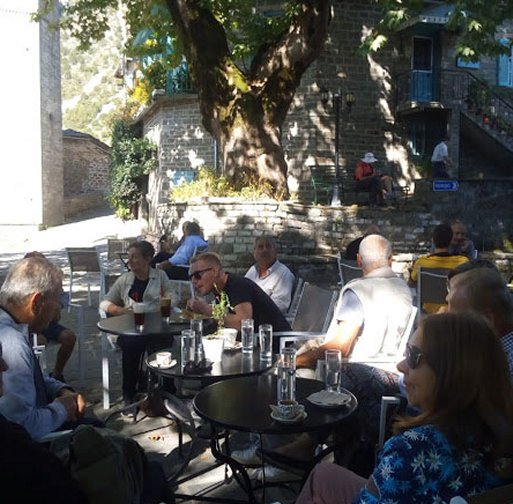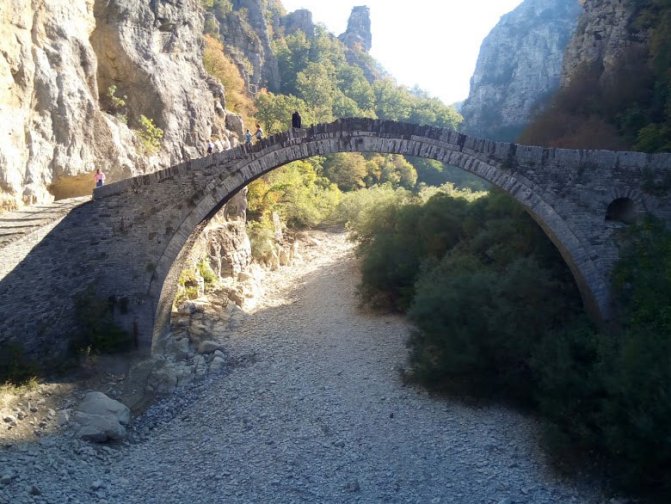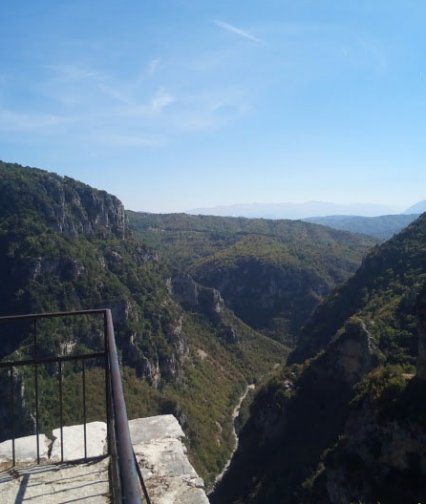F.O.L. - CULTURAL SOCIETY LONGOS "LORD BYRON"
ACTIVITIES OF THE CULTURAL SOCIETY LONGOS
The Managing Committee of Longos Cultural Society "Lord
Byron" organised in cooperation with MATTHEOS-TOURS/Egio an EXCURSION to
IOANNINA and
ZAGOROCHORIAfrom Saturday, September 22 to Sunday, September 23, 2018.
Service charge: : 70,00 EURO per person
|
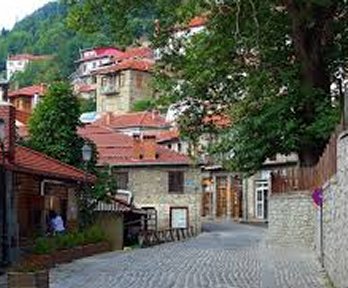
|
|
The service charge included transfer by bus, one stay in the hotel «Palladio» in Ioannina with breakfast and the tax according to law 4389/2016. Not included museums-fees etc.
More information and inscription:
Despina Manolopoulou, phone 6984 14 2411
Dimitra Prinou-Tsamtsouri, phone6976 61 6337
Eleni Ntourou, phone 6974 66 8577
|
PROGRAM
Saturday, September 22nd
7:00 a.m.m departure from Longos to Bizani,
Coffee break and visit of the genaral headquarters of the Balkan wars
1912-13 in the hani of Emmin Agha, where we got to know the history of
the liberation of Ioannina. Then we visited the Museum of Contemporary
Art «Theodoros Papagiannis» in Elliniko. Then we drove to the city of
Ioannina and visited Ioannina Island in Pamvotida Lake for lunch. Check
in at the hotel. Visit the sights of the city, e.g. the castle «Its
Kale». The evening was at leisure.
Sunday, September 23rd
After breakfast we drove to Zagoria. On the way we visited the
famous bridge of Kokkori. Then we drove to Kipi, where we visited
the three-arched bridge and the well-known museum «Agapios Tolis». Via
Kapetsovo and Tsepelovo (coffee break) we drove to Vitsa and
Monodendri, where the Vikos Gorge and Ag. Paraskevi monastery was seen
from above. Lunch in Monodendri. In the afternoon we drove via Kato
Pedina and Elafotopos to Kalpaki, where we visited the military museum
of the 1940s. We returned to Loggos via Ioannina and Bizani and arrived late at night.
|
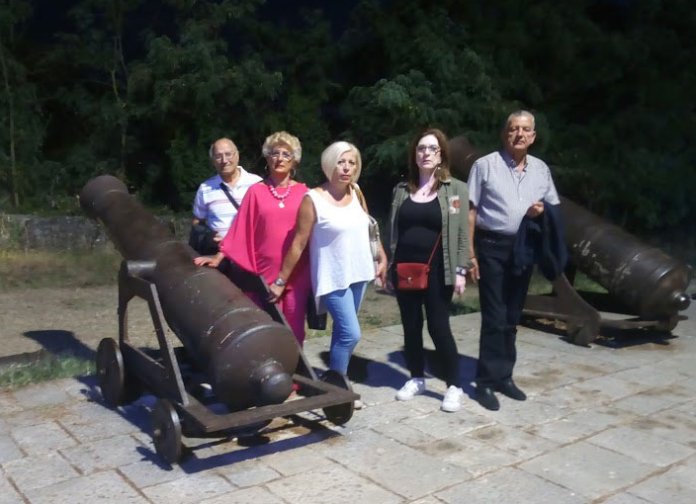 |
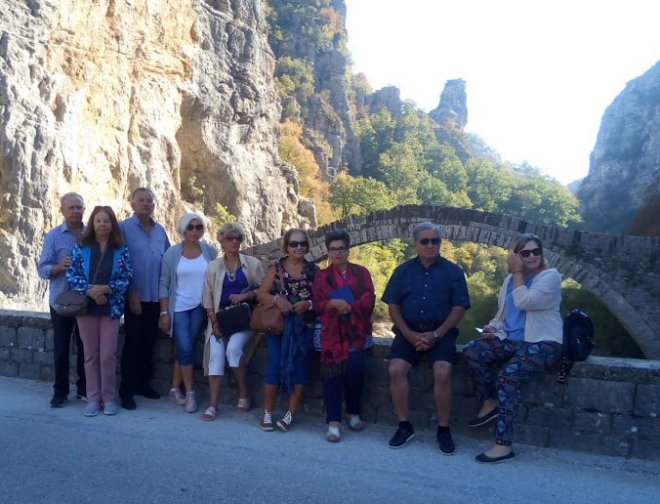 |
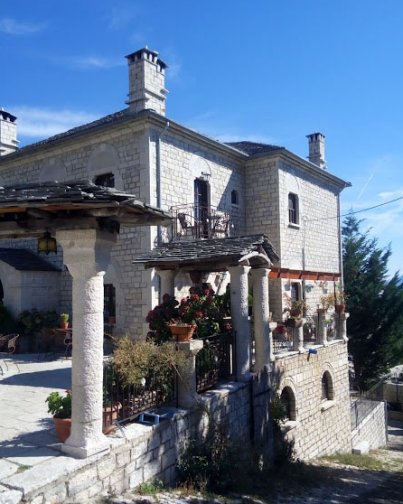 |
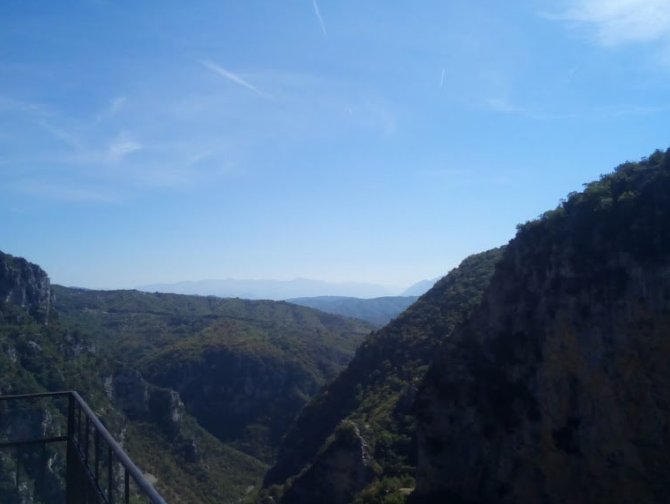 |
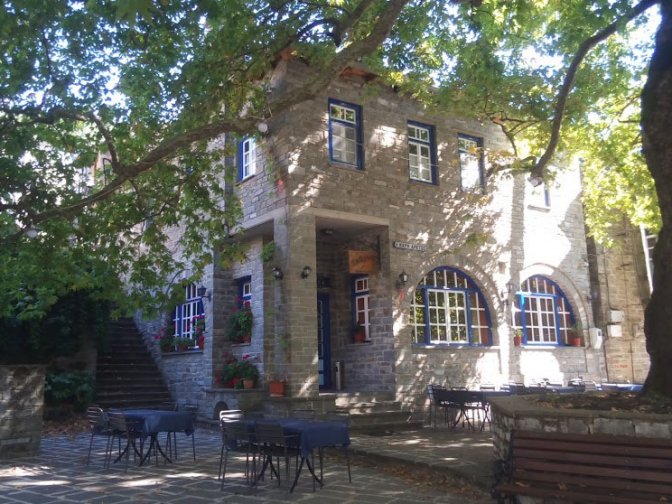 |
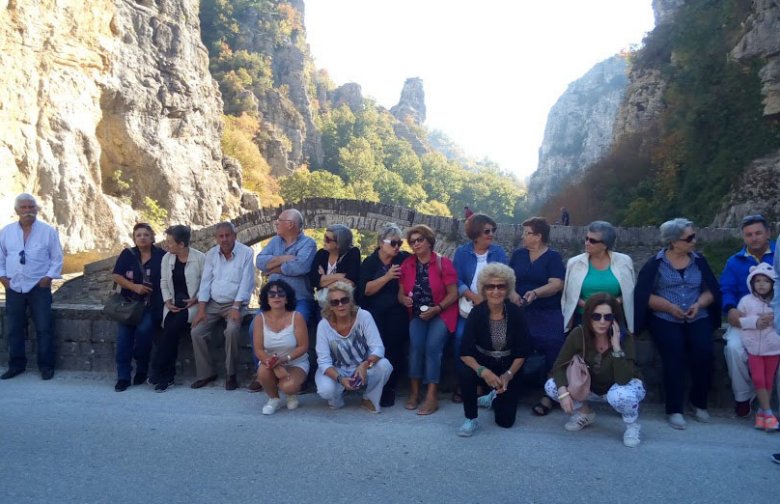 |
 |
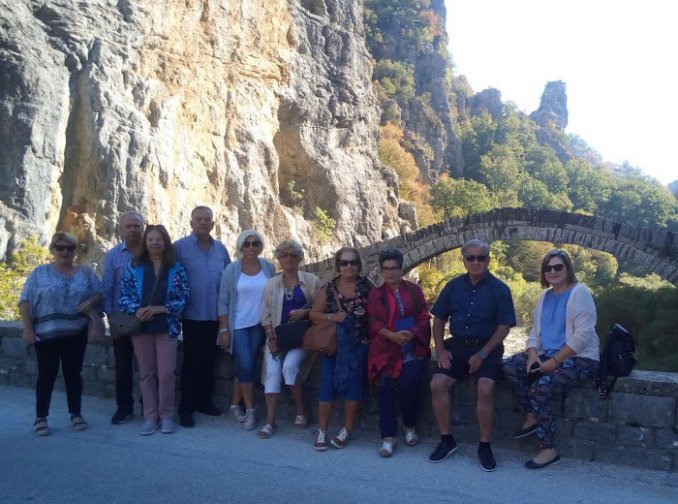 |
Bizani
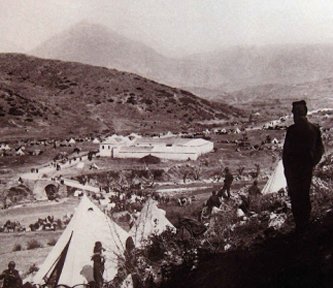
|
|
The village of Bizani is located 12 km from Ioannina, at the foothills
of Bizaniou Mountain, next to the national road to Preveza. Nearby are
the villages of Episkopico, Ambelia, Neoekaisaria, Koloniati and
Serviana. The dilapidated Old Bizani is located on the mountain Bizaniou near the fort.
The Battle of Bizani (4th to 6th March 1913, according to the Julian calendar 19th to 21st February) meant the main meeting of the Greek and Turkish arms in Epirus during the First Balkan War. The location of Bizani and the neighboring sites south of Ioannina chose the Turks as a natural defense to bind the Greek forces.
|
|
With the cyclical maneuver that finally succeeded the Greeks, they forced the opponent to surrender. The victory in Bizani was the key to the liberation of Ioannina and the entire Northern Epirus region. On March 6, 1913, with the acceptance of the surrender, the cavalry of the Epirus army came to Ioannina. The losses of the Greek army during the battle amounted to 264 dead and wounded.
|
Museum «Theodoros Papagiannis»
The museum, founded in Elliniko / Ioannina, strives to be unique in its kind.
Its uniqueness lies in the fact that it contains works that speak and glorify Epirus and its history, which is respected by every Greek who hears the name.
It is unique because it speaks of the bread, the benefactor, the migrant, the spiritual man, the master craftsman from Epirus, the shepherd, the
peasant, the heroic mother of Epirus.
The museum is housed in a beautiful old school by built by
great Epirus craftsmen with the money of the benefactor Nicholas
Mantelopoulos.
|
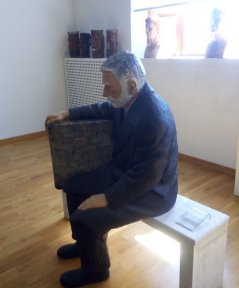
|
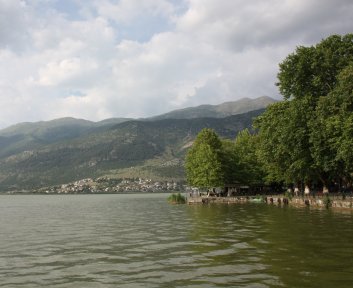
|
|
Ioannina
Ioannina is located in northwestern part of mainland Greece and is the capital
and largest city of the prefecture of Ioannina and Epirus, with a population of 65,574
residents (2011). It is one of the largest cities in Greece with
rich cultural tradition. Ioannina is the home of the University of
Ioannina with 14 faculties and over 20,000 students. Among the
different geographic features of the region the highlight is lake Pamvotis, which adjoins the city. Ioannina points
a wealth of attractions and museums. The most notable attractions are:
|
|
- The Archaeological Museum of Ioannina at Litaritsia Square. It
includes archaeological finds from all four provinces of Epirus, was renovated in 2008-2010 and has a high-quality ergonomic arrangement of the exhibits.
- The Citadel of Ioannina contains the Fetiche Mosque, the tomb of Ali Pasha
and the Byzantine Museum as well as the exhibition hall of the
Silverware. The name Fétithe Mosque means the conquest mosque, it was built in 1430 on the ruins of a Byzantine church.
Originally it was made of wood, but after 1611 it was remodeled as a stone construction. The final form was created in 1795 by Ali Pasha.
-The Byzantine Museum is located in a building erected on the
Ruins of the Ali-Pasha-Seraglio, which was completely destroyed by fire in 1870. The museum was inaugurated in 1995 and contains exhibits from the entire Epirus region, chronologically covering early Christianity, the Byzantine and post-Byzantine epochs. The collections include early Christian and Byzantine sculptures, finds from Arta, ceramics, books, Christian icons and and a remarkable cutlery collection. The museum is also a cultural center and venue for music and theater events as well as temporary exhibitions.
- The Aslan Pasha Mosque, dating back to 1618, now houses the Municipal
Museum with Christian, Jewish and Muslim collection. The museum displays local costumes, weaving products, wood carvings and silversmithing. The outstanding exhibit, however, is the sword og Georgios Karaiskakis. On the grounds of the museum are also the graves of important Turks and the tomb of Aslan Pasha. Outside the museum one can see cannons and bullets from this period.
- The Museum of Arts and Crafts is located in Citadel of Ioannina in the western bastion of the South-East Acropolis (Its Kale).
It occupies the two levels of the bastion as well as the building of the old cooks and is operated by the Cultural Foundation of the Piraeus Group (PIOP). Inaugurated in September 2016, the museum represents the history and technology of the silversmiths in the Epirus region.
- The Photios Rapakousis Museum is located in the building complex of the
Aslan Pasha Mosque in the northwest of the citadel. The community of
Ioannina operates the Photios Rapakousis collection since 2000
parallel with the Municipal Folklore and Ethnographic Museum, which is operated in the Aslan Pasha Mosque too. The entire collection comprises 6,000 exhibits, grouped into four categories: weapons and their components, 18th and 19th century jewelery, miscellaneous and ceramics (Islamic art, Greek pottery, Çanak Kale)
|
Bridge of Kokkoris
The bridge of Kokkoris or Noutsos is an impressive one-arch bridge between the villages of Koukouli, Dilofo and Kipi in the center of Zagorochoria. The approximately 24-meter-long and 13-meter high bridge was built in 1750 and has a special fame, which attracts hundreds of visitors every day.
Next to the bridge is an imposing vertical rock under which the river
flows with its crystal clear waters. Nearby there is a cave in which
robber Georgios Davalis (not the well known Christos Davelis) is said to have been hidden along with two other robbers.
Near the Kokkoris Bridge, a wooden makeshift bridge was constructed, on which the women of Pindos carried ammunition, weapons and supplies during World War II.
|
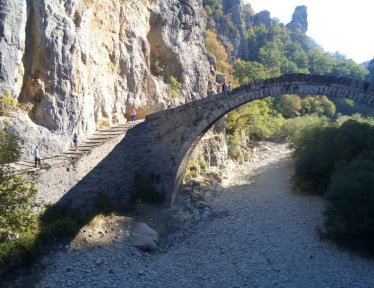
|
Kipi
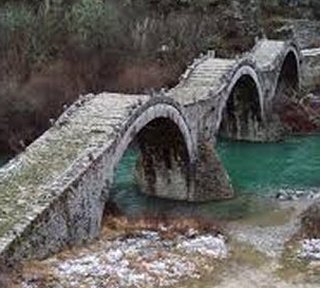
|
|
Kipi is a settlement in the municipality of Tympi, 39 km from Ioannina. The settlement retains elements of the area's traditional architecture,
with paved paths and traditional stone houses. In Kipoi is also the magnificent museum of Agapios
Tolo with its extraordinary collection of folklore material, while just outside the village there is a three-arch bridge with perfectly symmetrical arches.
The three-arched bridge of Plakida or Kalogeriko was built in 1814 and is one of the few three-arch bridge bridges that exist.
The bridge has earned special reputation, making it one of the most photographed
bridges of Zagori. Characteristic features are the toothed strips and the harmonious arrangement
the three bows that make them look like a moving caterpillar.
|
|
On the ground floor of the museum «Agapios Tolis» are weapons,
hunting utensils, woven goods, textiles, agricultural objects, shepherds' items and items for processing food.
Upstairs is a room dedicated to the collector Agapio Tolis. It shows furniture and exhibits of urban life and culture, objects made of ceramics and brass, jewelery, clothing, shoes as well as living and ecclesiastical objects.
|
Tsepelovo
Tsepelovo - 51 kilometers from Ioannina - is the largest
Village in the Zagori region. The traditional stone architecture is
ubiquitous in the houses, paths and churches of the village.
Outstanding is the cultural center «Estia», the church of Saint
Nikolaos, built in the 18th century as a three-nave dome basilica
and in 1786 its iconic painting were made by experienced
painters from Kapesovo, the churches of the Assumption, Kato Panagia and various villas of historical families of the village.
The Rogovos Monastery ist situated two kilometers outside of Tsepelovo, above the so-called "Vikaki" canyon. It was built in 1028-1034 and renovated in 1745.
|

|
Monodendri
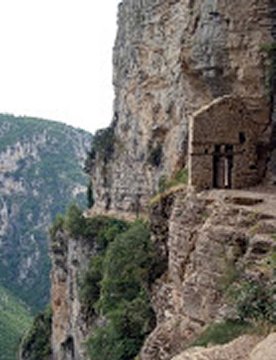
|
|
Monodendri is a mountain village on the northern edge of the Zagori region at an altitude of 1060 meters. It experienced a great commercial and economic development in the 17th and 18th centuries. The monuments of particular architectural importance are the Church of Saint Athanasios, restored at the expense of the Rizari brothers and dominating the central square of the village, the Church of Saint George (restored in 1538), the Monastery of Agia Paraskevi, built in 1412 on the precipice of the Vikos Gorge.
The monastery is less than one kilometer away from the village square and
is literally on the edge of the cliff of the largest gorge in the world,
the Vikos Gorge.
A paved path leads to the entrance of the
monastery, which has been here for over 600 years. It is a
monastery-fortress, with an archway as entrance, stone buildings, good
built cells and a well, all dominated by the artful
use of the stones.
|
|
The Vikos Gorge - the masterpiece of nature - is one of the
most famous gorges in Greece. It pervades the West and
the center of region of Zagori, starting at the village of Vikos and ending at the village Kipi. The
gorge has a length of about 12 kilometers and holds as the narrowest
gorge of the world - with an opening of only 1,100 meters - and a depth of over 900 meters a Guinness record.
|
Kalpaki
The area of Kalpaki was almost uninhabited before World War II. Today, Kalpaki is an important traffic hub and therefore of ongoing development.
Kalpaki was known by the eponymous battle against the Italian invasion in World War II.
On the slope of the hill Profitis Ilias the well-preserved "NO" testifies of that time and the epic of 1940. In the war museum soldiers answer as
Tour guides all questions of the visitors to the events of the war
and show rich exhibits as well as written and acoustic depictions of the Battle of Kalpaki.
|
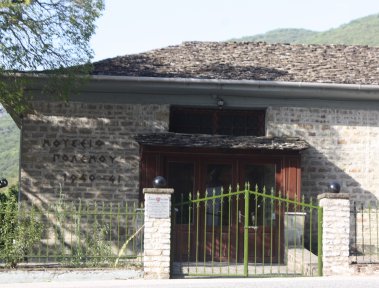
|
|
In early 1940, the 8th Epirus Division organized under the leadership of
Major Charalambos Katsimitros the defense of the surrounding hills of
Grampalas, Asonissas, Vellas and Gremision. On the hill of
Vellas traces of the trenches can be seen until this days.
Katsimitros saw, despite the opposing views of the General Staff
the defense in Tzoumerka and ordered the
defensive line in Kalpaki. It succeeded
Italian invasion was stopped and on November 10, 1940 the 8th
Division went over from defense to attack. Especially on the heights of
Grampala, east of Kalpaki, the bloodiest conflict was discharged.
|
<- back

















